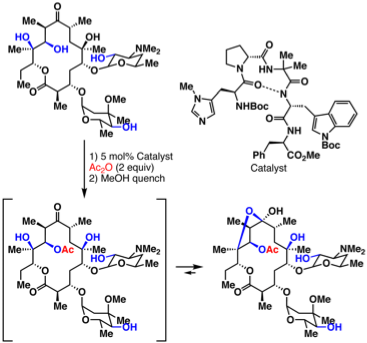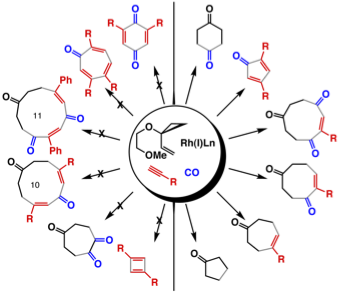Considerable recent advances in stereoselective synthesis allow great control over the processes that effect bond-forming and functional group transformations. These discoveries enable the efficient construction of molecules that conquer disease and influence biology. I seek to use computations to advance synthesis, by perfecting computational techniques to discover, explain, and quantify factors that control the selectivities and reactivities of complex synthetic organic reactions. The ultimate achievement of this line of research will be the routine and accurate prediction and design of selectivity and reactivity of homogeneous catalysts of all types and sizes.
Theory of Organic Catalysis - Organocatalysis to Peptides to Enzymes
Catalysis based on natural enzymes and proteins is the new frontier of green and efficient syntheses. The best of these reactions catalyzed by synthetic peptides rival the selectivities observed in enzymatic reactions. An example of this is Miller's discovery of a synthetic peptide for the selective acylation of the most hindered endo-macrocyclic hydroxyl in the natural product Erythromycin A (>10:1).

The
computational study of catalysis involving large organic systems is
the subject of active pursuit by numerous groups, but none of these
methods are routine, and all require substantial commitments of
resources without a guarantee of success. In the past, I have been
successful in understanding the selectivity of simple examples of
organocatalysis, and have been at the forefront of the design of
new organocatalysts. Now I seek to pursue the formidable challenge
of understanding and design of more complex systems. This requires
the development of techniques beyond what is available today. My
research will perfect the computational tools to simulate, analyze,
and predict the three dimensional structures, preorganization,
selectivities, and reactivities of organic catalysts, from the
small molecule catalysts to peptides, and finally to enzymes.
Theory
of Transition Metal Catalysis - Rh(I)-Catalyzed C-C Bond Activation
Reactions and Au(I)-Catalyzed Rearrangement
Reactions
Despite the
tremendous progress in the development of new reactions, ligands,
and theory, we have only begun to tap the power of transition metal
catalysis. For example, a number of intermolecular Rh(I)-catalyzed
multicomponent cyclo-addition reactions involving
vinylcyclopropane, alkynes, and CO are shown below. Those on the
right occur, while those on the left have not been observed to
date.

The
factors that determine the reactivity and selectivity of these
processes are not well understood. In the past, I have been
involved in close collaborations with the Wender and Toste groups
in using computations to address specific aspects of Rh(I)- an
Au(I)-catalysis. Now in my independent career, my research will
establish general principles that will explain and predict Rh(I)-
and Au(I)-catalyzed processes involving a wide variety of
substrates. The goals are to develop useful qualitative and
quantitative tools to predict the products of reactions involving a
wide variety of substrates. In the end, my research will result in
the complete understanding of Rh(I)- and Au(I)-catalysis,
encompassing the reactivity trends of catalysts, preferred
mechanisms, stable intermediates, driving forces, and substrate-,
stereo-, regio-, and chemoselectivity.
References